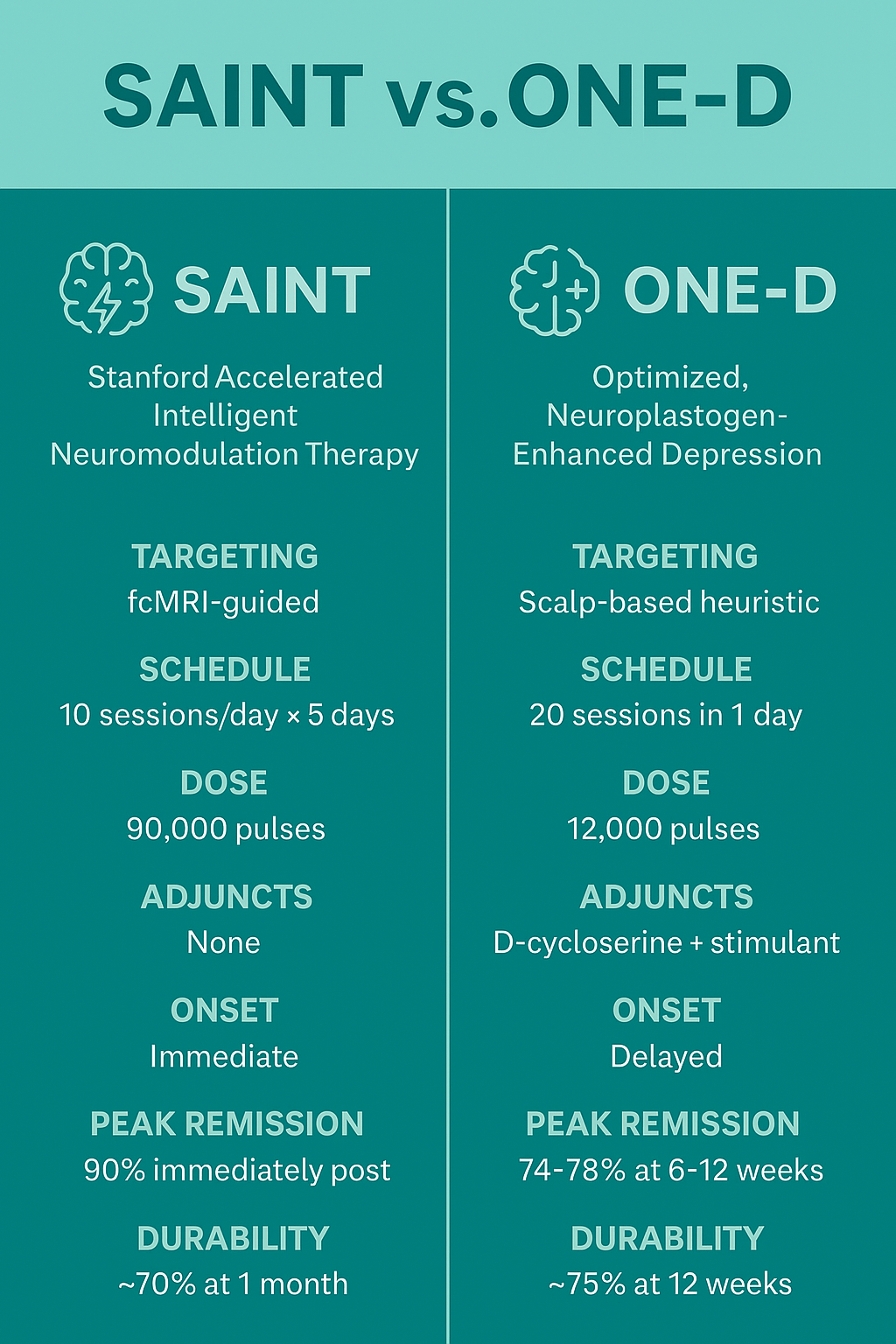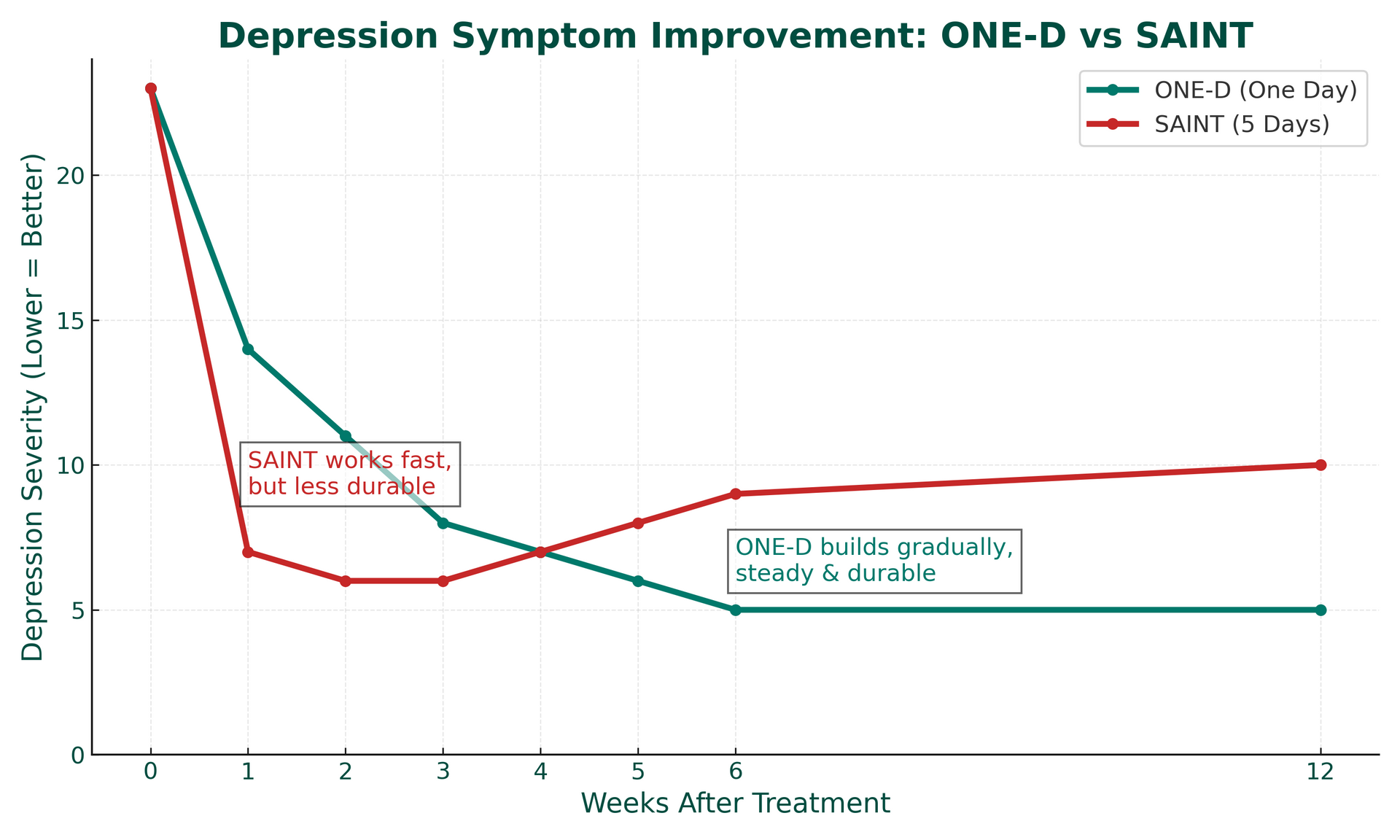ONE-D TMS: A Single-Day Accelerated TMS Therapy for Depression
Special Offer: ONE-D TMS Therapy for Just $1800!
Interested in ONE-D TMS Therapy?
What is ONE-D Accelerated TMS Therapy?
ONE-D TMS (Optimized, Neuroplastogen-Enhanced Depression treatment) is an innovative form of Accelerated TMS that delivers the equivalent of a full TMS course in just one day. Unlike traditional TMS, which can take 6 weeks, or SAINT TMS, which requires 5 consecutive days, ONE-D TMS condenses treatment into ~9.5 hours.
How it works:
- 20 iTBS sessions (intermittent theta-burst stimulation) in one day.
- Targeting: Left dorsolateral prefrontal cortex (L-DLPFC) using a validated scalp method (no MRI required).
- Adjuncts: A one-time dose of d-cycloserine (125 mg) and lisdexamfetamine (20 mg) 50–70 minutes before treatment.
- Spacing: Sessions delivered every 30 minutes, enhancing plasticity and cumulative benefit.
This makes ONE-D TMS a single-day depression treatment option that continues to work week over week until week 6 and excellent durabilty for 12 weeks at least.
Clinical Outcomes with ONE-D TMS
In a real-world study of 32 patients with treatment-resistant depression:
- Response rate: ~90% by week 6.
- Remission rates: 58–76% across scales at week 6, durable through week 12.
- Symptom trajectory: Symptoms steadily decreased week by week after the single-day accelerated treatment course.
- Safety: The most common side effect was scalp discomfort. No seizures or mania/hypomania were reported.
ONE-D TMS vs. SAINT TMS: What’s the Difference?
Both ONE-D TMS and SAINT TMS are advanced forms of Accelerated TMS, but they differ in speed, complexity, and logistics.
Key Features and Treatment Design
The core difference between SAINT and ONE-D lies in their approach to accelerated treatment.
- SAINT Protocol: This protocol delivers 50 iTBS sessions over five consecutive days. Patients receive 10 sessions per day, each with 1,800 pulses and a 50-minute interval between sessions to allow for a cumulative effect. The total pulse dose is 90,000 over the five days.
- ONE-D Protocol: In contrast, ONE-D is a single-day regimen that delivers a total of 20 iTBS sessions in one day 9.5-hour period. Each session is 3 minutes long and consists of 600 pulses, with a 30-minute interval between sessions.
Targeting and Neuroplasticity Enhancement
Both protocols use iTBS but differ in how they target the brain and whether they use additional enhancements.
- SAINT Protocol: SAINT uses a personalized targeting method with functional connectivity MRI (fcMRI) to identify the specific region of the left dorsolateral prefrontal cortex (L-DLPFC) that is most anti-correlated with the subgenual anterior cingulate cortex (sgACC). This individualized targeting is a debatable necessity for the protocol's success.
- ONE-D Protocol: The ONE-D regimen utilizes a non-personalized, scalp-based targeting method on the L-DLPFC. The protocol enhances neuroplasticity by administering a single, off-label dose of d-cycloserine and lisdexamfetamine one hour before treatment. These neuroplastogens may increase the brain's receptiveness to the stimulation, potentially reducing the proportion of non-responders.
Safety and Tolerability
Both protocols were found to be well-tolerated.
- SAINT Protocol: The study reported that the protocol was "well tolerated and safe," with no seizures or other severe adverse events. Neuropsychological testing showed no negative cognitive side effects.
- ONE-D Protocol: The ONE-D study found that all patients completed the regimen with no serious adverse events. The most common side effect was scalp discomfort.

Reported Efficacy and Outcomes
The studies for both protocols report high remission and response rates in populations with treatment-resistant depression.
- SAINT Protocol: In an open-label study of 31 participants, 28 (or 90.32%) met the criteria for remission immediately following the five-day treatment. One month after treatment, 59% of participants continued to meet responder criteria.
- ONE-D Protocol: A retrospective case series on 32 patients showed a 74.2% remission rate and a 90.3% response rate at the six-week mark. These high rates were sustained, with similar rates reported at the 12-week follow-up.

| Feature | ONE-D TMS | SAINT TMS |
|---|---|---|
| Treatment Duration | One single day | 5 consecutive days |
| Number of Sessions | 20 sessions | 50 sessions (10 per day) |
| Session Details | 3-minute sessions with 600 pulses each, delivered every 30 minutes | 9-minute sessions with 1,800 pulses each, delivered every 60 minutes |
| Total Pulses | 12,000 pulses | 90,000 pulses |
| Targeting | Scalp-based targeting on the L-DLPFC | fcMRI based targeting the L-DLPFC |
| Enhancements | Enhanced with single, off-label doses of d-cycloserine and lisdexamfetamine | No neuroplastogens enhancement |
| Remission Rate (Immediate) | Immediate response and remission are not the goal | 90.32% at day 5, but a significnt drop in the weeks after |
| Remission Rate (Long-term) | 74.2% at 6 weeks, and 77.8% at 12 weeks | 59% of participants continued to meet responder criteria at one month |
| Safety and Tolerability | Well-tolerated with no serious adverse events | Well-tolerated and safe; no seizures or other severe adverse events |
Why Patients Consider ONE-D TMS
- Convenience: Completed in one day, unlike 5-day SAINT TMS or 6-week standard TMS.
- Durable benefit: Improvements last at least 12 weeks in most patients.
- Accessibility: No MRI needed, unlike SAINT TMS.
- Affordability: ONE-D TMS is self-pay but more cost-effective than SAINT TMS.
Practical Questions about ONE-D TMS Protocol
- Is ONE-D FDA-cleared?
No. It’s built on FDA-cleared TMS, which is iTBS, but uses off-label augmentation.
- Who might consider it?
Patients unable to commit to 5-day or 6-week regimens; those seeking one-day care with gradual improvement.
- Side effects?
Scalp discomfort, headaches, and transient jaw soreness; no major safety issues reported.
- Insurance coverage?
Only the traditional TMS protocol is covered by insurance. The ONE-D accelerated TMS protocol is self-pay and significantly more affordable than SAINT, which insurance does not cover.
- Cost of ONE-D TMS?
$1,800 at FLORIDA TMS CLINIC. (compare to SAINT TMS $12,000 to $28,000 and Traditional TMS $7,200 to $15,000)
Key Takeaways
- ONE-D TMS is a single-day accelerated TMS treatment for depression.
- Unlike SAINT TMS, which acts in days, ONE-D TMS builds effect over weeks but delivers durable, lasting outcomes.
- For patients seeking Accelerated TMS that balances effectiveness, convenience, and practicality, ONE-D may be the best option available today at a fraction of the cost of other accelerated TMS therapy protocols.


